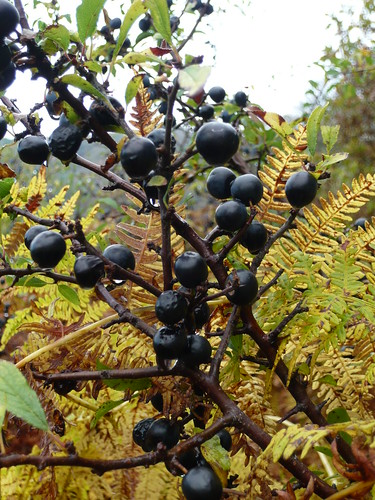Blackthorn and Sloes

Blackthorn is a multi branched, deciduous tree or bush that can grow up to 20 feet tall (the Blackthorn in this photo was 7 feet tall as were the ferns!).
The stem is dark to black and the small branches create thorns hence the name Blackthorn but in Latin Prunus Spinosa.
Like its relative the Cherry plum, Blackthorn produces small fruit we know as Sloes.
The thorns can be very sharp and the bush can be a bit ragged unless kept in check.
Blackthorn is often used for and found in hedgerows or on the edges of woodland and is easy to grow as part of your mixed hedge. In early Spring it is covered in small white blossom before the leaves come into bud. Blackthorn is good for attracting butterfly caterpillars but is best known for the small, spherical, blue-black fruit that are available in late Autumn.
Sloe Gin
A raw sloe has a sharp and astringent taste and is best used for Sloe Gin. ‘Pick sloes after the first frost, prick them all over with a needle and for every pound of sloes you collect, pour over 8 oz of caster sugar and 1 ¾ pints of gin, then seal.’ You can leave the gin for as little as two months to steep. The longer you keep it the smoother the drink becomes.
Vodka can also be infused with Sloes.
Straight Blackthorn stems have traditionally been made into walking sticks or the Irish Bata more popularly known as a shillelagh.
In Rudyard Kipling’s song the Hawthorn and Blackthorn, often growing together, were celebrated thus:
“Of all the trees that grow so fair,
Old England to adorn,
Greater are none beneath the Sun
Than Oak and Ash and Thorn.â€
One thought on “Blackthorn and Sloes”
we live near the cannock chase, wondering whether you may have any idea if sloes have been spotted growing in this area. thank you for you time
Comments are closed.